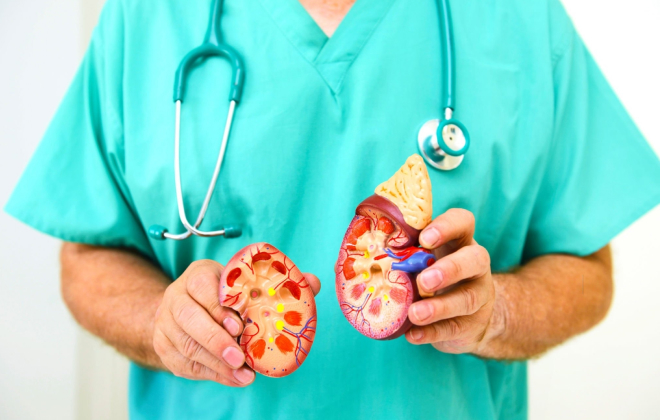


Our kidneys are remarkable organs which filter waste and excess fluids from our bloodstream to keep our body healthy. Hence, maintaining good kidney health is crucial for maintaining our overall well-being. Any abnormalities or diseases affecting these vital organs can have serious consequences.
Kidney tumours are abnormal growths that develop in the kidneys. These tumours can be benign (non-cancerous) or malignant (cancerous). Understanding the types of kidney tumours is essential to determine the appropriate diagnosis and treatment plan.
Kidney tumours can be of various types, the most common being:
Renal cell carcinoma, often abbreviated as RCC, is the most prevalent type of kidney cancer. It originates in the lining of the renal tubules, the small tubes within the kidney that filter waste from the blood to form urine. RCC accounts for about 85% of all kidney cancer cases.
Transitional cell carcinoma, also known as urothelial carcinoma, affects the lining of the renal pelvis, ureter, or urinary bladder. While it primarily starts in the bladder, it can sometimes extend into the renal pelvis or ureter, causing kidney tumours.
Wilms tumour primarily affects children and is one of the most common kidney tumours in paediatric patients. It typically occurs in children aged 3 to 4 years but can sometimes be found in older children or adults. Wilms tumours originate in the kidney’s embryonic cells and can grow quite large.
Oncocytoma is a benign tumour that usually doesn’t cause symptoms and doesn’t spread to other parts of the body. While it is non-cancerous, it may require treatment if it becomes too large or causes discomfort.
Angiomyolipoma is another benign kidney tumour composed of blood vessels, smooth muscle cells, and fat. It is usually harmless but can cause complications if it grows large enough or starts to bleed.
Understanding the risk factors associated with kidney tumours can help you take preventive measures and seek early detection. Common risk factors include:
Kidney tumours, whether benign or malignant, can exhibit various symptoms. However, it is important to note that early-stage kidney tumours often do not cause noticeable symptoms, which is why regular check-ups and screenings are important, especially for individuals with risk factors. Here are some common symptoms associated with kidney tumours:

Early diagnosis of kidney tumours is crucial for effective treatment. Various diagnostic tools and procedures help healthcare professionals determine the presence, type, and extent of kidney tumours. Let us take a look at them.
A thorough medical history review and physical examination are often the initial steps in diagnosing kidney tumours. The healthcare provider will enquire about symptoms, risk factors, and family history while conducting a physical examination to check for any abnormalities or signs of tumours.
Imaging tests are instrumental in visualising the kidneys and detecting tumours. Common imaging modalities used for kidney tumour diagnosis include:
In some cases, a biopsy may be necessary to confirm whether a kidney tumour is cancerous. A biopsy involves the removal of a small tissue sample from the tumour, which is then examined under a microscope by a pathologist.
Blood and urine tests can help assess kidney function and detect any abnormalities. Elevated levels of certain substances in the blood or urine, such as erythropoietin or parathyroid hormone, may be indicative of kidney tumours.
Several factors influence the prognosis of kidney tumours, including:
The choice of treatment for kidney tumours depends on several factors, including the type of tumour, its size, stage, and the patient’s overall health. Here, we explore various treatment options for kidney tumours.
In cases of small, low-risk kidney tumours, active surveillance may be a viable option. This approach involves closely monitoring the tumour’s growth with regular imaging tests, such as CT scans or MRIs. Surgery or other treatments are considered if the tumour shows signs of growth or progression.
Surgical intervention is the primary treatment for many kidney tumours. The type of surgery performed depends on the tumour’s size and location. Common surgical procedures include:
Ablation procedures are used to destroy kidney tumours without surgical removal. They may be considered for smaller tumours or for individuals who are not good candidates for surgery. Common ablation methods include:
Targeted therapy is a type of systemic treatment that uses drugs to target specific molecules or pathways involved in cancer growth. It is often used for advanced kidney cancer. Common targeted therapy drugs include sunitinib, pazopanib, and axitinib.
Immunotherapy helps the body’s immune system recognise and attack cancer cells. Immune checkpoint inhibitors, such as nivolumab and pembrolizumab, have shown promise in treating advanced kidney cancer.
Radiation therapy uses high-energy X-rays or other radiation sources to kill cancer cells. It is not typically a primary treatment for kidney tumours but may be used to relieve symptoms or shrink tumours in specific cases.
While not all kidney tumours can be malignant, some are. However, all is not lost if a kidney tumour turns out to be cancerous.
Kidney cancer survival rates can vary widely based on the prognosis factors. Generally, the five-year survival rate for kidney cancer is around 75%, meaning that 75% of people diagnosed with kidney cancer live at least five years after diagnosis.
However, survival rates can be much higher for early-stage tumours and lower for advanced-stage disease.

A diagnosis of kidney tumours can be life-changing, and it often brings a host of physical, emotional, and practical challenges. Let us discuss some coping mechanisms that can help a patient or a caregiver deal with this diagnosis.
Regular follow-up appointments with healthcare providers are essential to monitor the progress of treatment and check for any signs of recurrence. Patients should adhere to their recommended follow-up schedule and report any new symptoms or concerns promptly.
Kidney tumours and their treatments may necessitate lifestyle adjustments, including dietary changes and modifications to physical activity. Patients should work closely with their healthcare team to develop a personalised plan that suits their needs.

Kidney tumours, whether benign or malignant, are a serious health concern that requires careful diagnosis and consideration of treatment options. Advances in medical technology and treatment strategies have significantly improved the outlook for individuals facing kidney tumours.
Early detection, coupled with appropriate treatment, can lead to better outcomes and improved quality of life. It is essential for individuals at risk or experiencing symptoms to seek medical attention promptly and work closely with healthcare providers to develop a personalised treatment plan tailored to their unique circumstances. While kidney tumours can be challenging to navigate, with the support of medical professionals, loved ones, and a resilient spirit, many individuals can successfully overcome this and enjoy a fulfilling life beyond their diagnosis.
Sources:
Spread the love, follow us on our social media channels